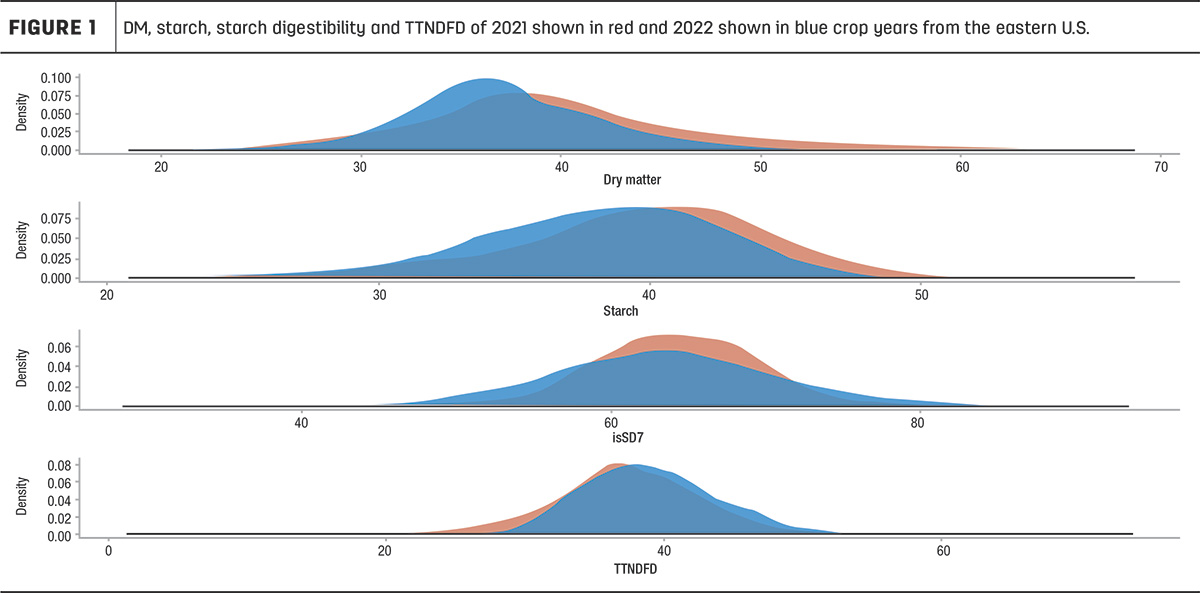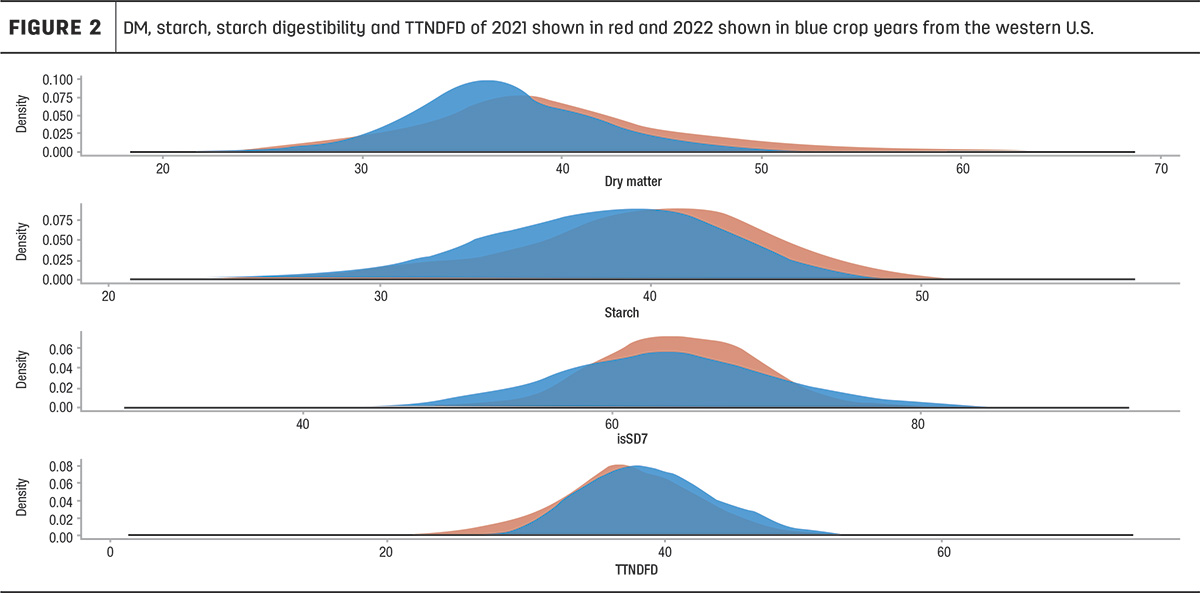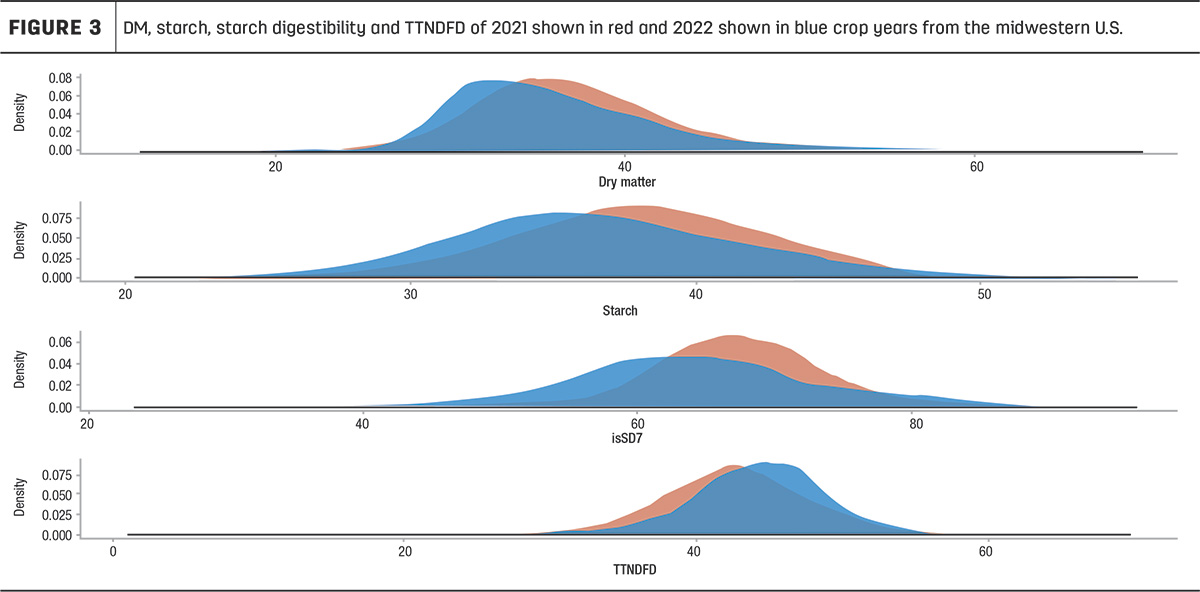Opening a new bag of silage often feels like a shot in the dark. We aren’t quite sure what to expect. In some years, we see little changes from previous silage crops, while in others we see larger leaps. Although we can’t necessarily change the feeds we have harvested, we can use data to help us better understand what may be to come.
Differences in feed quality from year to year can be influenced by a variety of factors, one of them being the environment. Conditions such as drought, excess rainfall and cooler- or warmer-than-normal conditions can all be cause for changes in crop quality. 2023 gave us a little bit of everything, and some experienced all in the same geographic region.
While the verdict may still be out on the impacts of drought on fiber quality, we know that severe drought can cause decreases in starch content. There could also be increased heterogeneity of starch content throughout the pile, as some fields, or even areas within the fields, that experienced drought conditions may have also had poorer pollination. Meanwhile, other fields in drought that have better soil quality or simply received more rainfall may see closer-to-average starch levels.
Eastern U.S.
The eastern U.S. 2023 crop looks to be down slightly in starch compared to 2022, with lower in situ starch digestibility. The net combination of these has also reduced rumen-degradable starch (RDS) compared to 2021 and 2022 silage. However, proper ensiling time, when the situation allows, may help improve overall RDS. Dry matter (DM) is also slightly down from years past, accompanied by marginally improved total tract neutral detergent fiber (NDF) digestibility (TTNDFD). In many aspects, this corn silage is reminiscent of the 2021 corn silage crop (Figure 1).

Western U.S. corn silage
Starch continues to be a topic of conversation in western U.S. corn silage. Although starch levels look to have rebounded slightly from 2022 levels, we are still, on average, 1.5 units lower than 2021. This, coupled with starch digestibility levels at a three-year low, may leave silage a bit lackluster. Outstanding kernel processing score (KPS) in the silage may help combat some of the reduced starch digestibility. Fiber digestibility parameters TTNDFD, NDF digestible at 30 hours (NDFD30) and undigested NDF (UNDF240) appear similar to previous years (Figure 2).

Midwestern U.S. silage
The Midwestern U.S. corn silage tested so far has been narrowly lower in DM. This, accompanied with greater fiber digestibility, could suggest that corn was harvested at a somewhat more immature stage compared to 2022. Starch and starch digestibility also appear lower compared to last year's corn silage. Overall higher TTNFD and NDFD30 may help overcome some of the lost energy due to the aforementioned reductions. Ensiling length can also be used to help overcome some of what the 2023 crop may be lacking in starch digestibility. A notable quality of the 2023 corn silage to keep an eye on is variability, as this crop looks a bit more variable in starch and starch digestibility than years previous, likely due to the aforementioned drought conditions. This variability can lead to big shifts in energy supply (Figure 3).

We know there is heterogeneity from year to year; however, there is also always a degree of deviation in the silage harvested within the same year. This is especially true as the size of silage piles increases following increasing farm sizes. To try to capture this variation in a traditional sampling schedule can be quite a feat. And, even with some data collected from the feed, it may still feel like a bit of a shot in the dark, especially when faced with extreme fluctuation in forages. Over the past year, I’ve noted many situations where nutrient content or digestibility of feed changes steeply without warning and may be independent of moisture changes. This situation poses many challenges. If we are faced with an 8%-10% change in nutrient composition of our feed, how do we act upon those results?
Based on the work presented by Dr. Bill Weiss and Dr. Normand St. Pierre, this could stem from sampling variation, true nutrient changes or even lab errors. So, do we adjust the ration based on one feed test? The answer to this question likely varies depending on who you talk to. It likely results in some combination of adjusting the ration and retesting. However, this approach is largely reactive versus proactive. When dealing with extremely variable forages, a reactive approach can produce economic or even production consequences. Where I once thought large changes in silages within the same pile were the outlier situation, I’m beginning to see they are far more common than previously assumed.
Dealing with feed variation
A potential culprit of increased variability is the pile size that accompanies growing dairies. With larger piles and a larger volume of feed going into each one, a pile can encompass a wide geographical range of feed subject to a multitude of growing conditions and soil types. Semimonthly or weekly samples may not be enough to help accurately guide our decisions, as seen in Figure 4. The center dot corresponds to the average starch and DM of this corn silage over one month. This silage is being sampled three times per week. If we look at two hypothetical situations – one sampling two times per month and another one time per week – compared to the third graph showing all samples taken in this time frame, we see that traditional sampling methods may not give us an accurate representation of the feed.

Sampling more frequently is associated with increased cost and labor, but the variability that more sampling captures, and the confidence that comes along with increased sampling, far exceeds the added costs. Especially for herds over 1,000 head. This is also not limited to corn silage, as variability is noted across all crops, including haylages and small-grain silages.
When evaluating forages year to year, we are often faced with several unknowns. However, reviewing tracked data from what has been harvested can give us a better idea of what to prepare for when we begin feedout. As we look to best handle variability in our feeds, sampling frequency should be considered, as frequent alterations can often help shed much-needed light on the decisions made regarding our forages.










